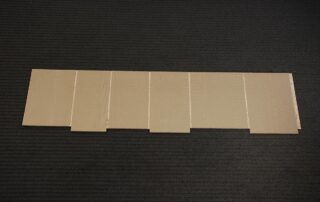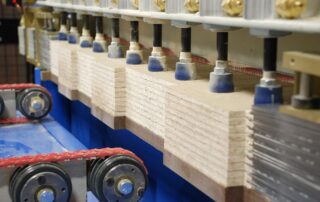New Siding Line Redesigns Manufacturing Process for Significant Production Increase
Creative Automation is often called upon to produce processing equipment for a wide range of product categories, most often within the woodworking industry. When a product begins to show signs of broader market acceptance, companies often have to ramp up manufacturing while striving to maintain the original selling characteristics of the product.
A Complete Redesign of the Manufacturing Process
In this day of plastic shutters and vinyl siding, a Midwestern company has carved a niche in the siding industry with a real wood siding product that retains the charm and desirable characteristics of traditional shake siding.
With a growing sales forecast ahead and existing production capacity already reaching its limit, the challenge was to develop a production system that would exponentially increase production output. Further, the manufacturer desired flexibility in easily producing differing profiles in the future. Accomplishing their production plans would require a specialized processing line with considerable capacity and flexibility.
Creative Automation was entrusted to build an entirely new production line, including all processing equipment and accompanying material handling. The three primary project guidelines included maintaining high perceived product value, single-passing “raw materials to finished product,” and achieving a significant increase in production output.
Processing Line Strategy
Creative Automation engineers designed a complete product flow, beginning with full-size panels and ending with completed single shakes stacked on pallets, ready for painting. The operational sequence is as follows:
- A vacuum feeder automatically feeds full-size panels into the line.
- Rain grooves and rabbeting for siding overlap are machined lengthwise on the panels.
- A stack of panels is formed with a drop angle stacker. By stacking panels, throughput is maximized throughout the rest of the line.
- A leading trim cut is taken on the stack, and the scrap is dumped.
- The stack is indexed through the crosscut/haunching area where final cutting and profile machining are performed.
- Trailing scrap is dumped.
- Multiple stacks of siding are collected into a layer.
- A drop angle stacker places each layer on a pallet.
- Finished loads are indexed out automatically while an empty pallet is transferred in for the next load.
Final Output: 10,000 Parts per Shift
Previously, the product was produced on a CNC router with limited production capacity and high labor costs. The new line has increased production output exponentially, enabling the company to fulfill current and future demand. They can also introduce new product profiles to the marketplace without additional equipment or labor.
As a further benefit to their bottom line, the system can accept incoming panels anywhere from 4 to 16 feet long, giving the manufacturer wide latitude in sourcing raw materials at the best pricing. The line automatically cuts as many pieces of siding as possible from whatever length it is given.
Design and Manufacturing Control Offers Better Results
Because each stage of the process is handled in-house (salespeople who are themselves engineers, mechanical engineering, electrical engineering, manufacturing, programming, testing, and installation), Creative Automation can maintain full control of your project, minimizing delays and ultimately creating a more capable and longer-lasting manufacturing product.
Choose a Partner Experienced in a Wide Range of Processing Environments
One of the biggest advantages of dealing with a manufacturer with the breadth of capability Creative Automation has amassed is the wide-ranging experience our engineers have in solving a host of production challenges. If your sales forecasts are beginning to show signs of overtaking your production capacities, contact Creative Automation at 715-223-6321 to start discussing how Creative Automation can increase production while maintaining or increasing the quality and profitability of your products.





